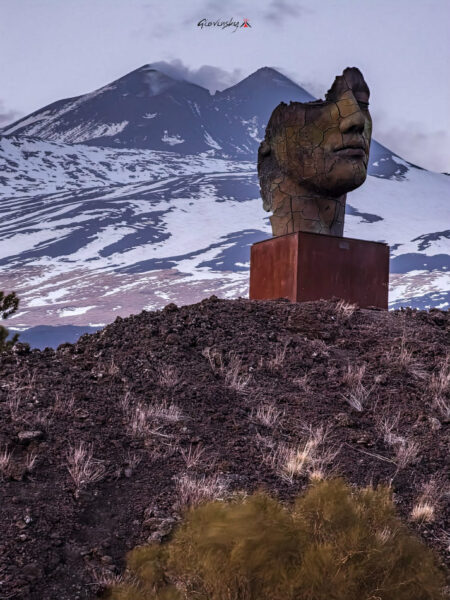In March 2024 a giant statue “appeared” on Mount Etna. A sleeping human face split in half, rising on a cube-shaped pedestal, atop a sciara (old lavas). It seems to admire the entire coast from above, with an expression of seraphic peace that invites you to relax and fully enjoy the mountain air. It is Teseo Screpolato – Cracked Theseus – by Igor Mitoraj, a traveling work that grows in popularity every year. Associated with the splendid view of the volcano and the Sicilian coast, it becomes an undoubted attraction for tourists. And it’s worth seeing! The statue will remain on display until October 2025.
 PHOTO BY Giovinsky Aetnensis
PHOTO BY Giovinsky Aetnensis
Igor Mitoraj and the monumental statues
Igor Mitoraj was born in 1944 in Germany to French-Polish parents and spent his early youth in Poland, in Grojec, where his parents divorced and he was officially adopted by his mother’s second partner, Czes?aw Mitoraj. In 1968, at the age of 24, he moved to Paris to complete his artistic studies started in high school and divided his time between painting and sculpture. After a long trip to Mexico he returned home in love with sculpture and dedicated himself totally to it.
From his subsequent travels he will learn new precious techniques, especially for working with bronze and terracotta; he will also dedicate himself to marble sculpture. His works are characterized by their gigantic dimensions, so that they are often used as sets for outdoor shows. His style is neoclassical, even if modernity breaks into his work precisely in the form of “damage” (scratches, crazing, cracks). Among his most important works: Body and Crucifixion (Volterra), Fallen Icarus (Agrigento), Weeping Venus (Rome), Blindfolded Eros and Winged Broken Legs (Krakow), Sleeping Head (London).
Mitoraj died in 2014 at the age of 70. His Teseo Screpolato was completed in 2011.
Theseus and the Volcano
Mitoraj’s Cracked Theseus is part of a widespread posthumous exhibition dedicated to the great Polish sculptor. “Mitoraj. Lo Sguardo, Humanitas, Physis” effectively involves all of Eastern Sicily and not just Etna, and includes exhibitions of his statues both in the city of Syracuse, and at the Archaeological Park of Neapolis, and – indeed – on the volcano. All the works are outdoors following a route that allows you to admire, together with the statues, some of the most evocative places on the island.
Teseo Screpolato was placed on top of a sciara in the Serra la Nave, Ragalna area (South Etna). The size is so big that the pedestal alone measures the size of an average-height man. The material is bronze, as denoted by the greenish colour that the statue takes on in the sun. The cracks that seem to crumble the large face have the top of Etna as a backdrop; to be precise, both the Central Crater and the South East Crater, which make the statue very suggestive when eruptions and lava fountains occur. If, however, you look in the same direction as the Theseus, you can admire the Gulf of Catania in its full splendor.
Not far from Teseo Screpolato, just 3 minutes away by car (about 15 on foot), a delightful woodland road leads to the panoramic esplanade of Piano Vetore. From Teseo statue, Refuge Sapienza and the Etna cableway are less than a 10-minute drive away.
Tips for photographing Theseus
Needless to say, the competition started to take “selfies” together with the large statue. The selfie is always excellent for the occasion, as long as you have the light on your face and not behind you.
long as you have the light on your face and not behind you.
For those who want to portray Theseus with the camera, the advice we give you is to try long exposures after sunset and in the evening, in order to stop the effects of residual sunlight (or moonlight) in the correct way.
You can also photograph the statue on a clear, windy day, with a beautiful blue sky in which white clouds run. In the absence of clouds, take advantage of the vapor trails of the airplanes which very often draw interesting geometries precisely on that corner of the sky, creating fabulous frames around the statue.
Obviously the ideal would be to photograph Theseus with a spectacular eruption behind it. But to do this, we need to wait for Etna to decide to satisfy us!
PAY ATTENTION! Avoid taking frontal photos of the statue. To do them, you would have to walk a few steps away on very loose terrain with the serious risk of falling backwards onto the rocks and getting badly hurt. If you really want to shoot Theseus “in the face”, make sure you take the photo from the street with a good zoom.
Reaching Theseus…
From Zafferana, going up along the Provincial Road SP 92 to Refuge Sapienza, then follow the same road towards Piano Vetore. Once there, just go straight down the curves through the woods of the Adventure Park, skirting the Ariel Refuge and the access gate to the Filiciusa Woods. The Theseus will appear on the right, on the same roadside. From Ragalna, drive up along Via del Bosco, then take Strada Milia and continue going up until you find the statue on the left, on the same roadside. From Nicolosi, drive up towards Etna via the SP 92-Strada Milia.
If you are arriving from outside and want advice on where to stay, we invite you to look for a B&B in Nicolosi or Ragalna. Or alternatively do sleep at the Refuge Sapienza. (photos by G.Musumeci and Giovinsky Aetnensis )